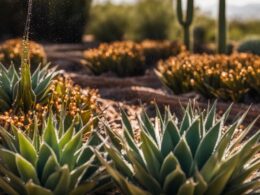Xeriscaping is a landscaping approach that focuses on using plants and techniques that require minimal water in dry climates. It is an environmentally friendly and sustainable way to create and maintain a beautiful landscape while conserving water resources. The principles of xeriscaping include selecting the right plants for the right place, minimizing the use of water, fertilizers, and pesticides, and planning the soil, plants, grass, mulch, and water to ensure the longevity of the landscape.
Key Takeaways:
- Xeriscaping is a landscaping approach that focuses on using plants and techniques that require minimal water in dry climates.
- The principles of xeriscaping include selecting the right plants for the right place, minimizing water usage and the use of fertilizers and pesticides, and planning the soil, plants, grass, mulch, and water to ensure the longevity of the landscape.
- Xeriscaping in dry climates offers benefits such as water conservation, environmental sustainability, cost savings, and increased property value.
- Practical tips for xeriscaping include proper soil preparation, selecting drought-tolerant and native plants, implementing efficient irrigation methods, incorporating hardscaping elements, and regular maintenance.
- Embracing xeriscaping in dry climates is a responsible choice that enhances the beauty and value of outdoor spaces.
The Principles of Xeriscaping
The principles of xeriscaping are rooted in water conservation and the use of native plants. By following these principles, you can create a sustainable and beautiful landscape that thrives in dry climates. The key to successful xeriscaping lies in matching the right plant to the right place, minimizing the need for excessive watering, fertilizers, and pesticides.
One of the fundamental principles of xeriscaping is the use of plants that are adapted to the local climate and can thrive in dry conditions. By selecting native species or drought-tolerant plants, you can significantly reduce water requirements while still enjoying a vibrant and diverse landscape. These plants have evolved to withstand the challenges of arid environments and can excel without the need for constant watering or chemical support.
Another important aspect of xeriscaping is the proper planning of soil, plants, grass, mulch, and water. By creating a well-designed landscape, you can ensure the longevity and sustainability of your xeriscape. This may involve techniques such as improving soil quality, implementing efficient watering systems, and incorporating mulch to retain moisture in the soil. By considering these factors during the planning stage, you can reduce the maintenance needs of your xeriscape and create a low-maintenance oasis in a dry climate.
About Native Plants
Native plants play a crucial role in xeriscaping. They have adapted over time to the specific climate, soil, and other conditions of a particular region, making them resilient and well-suited for a xeriscape. Native plants often require less water, fertilizer, and maintenance compared to non-native species. They also support local ecosystems and enhance biodiversity, attracting beneficial insects and birds. By incorporating native plants into your xeriscape, you can create a beautiful and sustainable landscape that is in harmony with the natural environment.
Practical Tips for Xeriscaping
Xeriscaping in dry climates requires careful planning and attention to detail. By following these practical tips, you can create a stunning and water-efficient landscape:
1. Soil Preparation:
Before starting your xeriscaping project, it’s important to prepare the soil properly. Test the soil to determine its composition and pH levels. If necessary, amend the soil with organic matter, such as compost, to improve its quality and drainage. Well-prepared soil provides a solid foundation for the plants to thrive.
2. Plant Selection:
Choose plants that are well-suited to the dry climate and require minimal water. Opt for drought-tolerant and native species, as they are naturally adapted to local conditions. Consider the mature size and growth habit of the plants to ensure proper spacing and avoid overcrowding. Group plants with similar watering needs together for efficient irrigation.
3. Efficient Irrigation:
Implement water-efficient irrigation methods to minimize water waste. Drip irrigation systems deliver water directly to the plant roots, reducing evaporation. Consider installing rainwater harvesting systems to collect and store rainwater for later use. Utilize timers and moisture sensors to ensure optimal watering schedules and avoid over or under-watering.
4. Hardscaping Elements:
Incorporate hardscaping elements, such as pathways, rocks, and retaining walls, to add visual interest and functionality to your xeriscape. These features can help conserve water by reducing the amount of turfgrass and providing heat and drought-resistant surfaces. Use permeable materials to allow water to penetrate the soil, preventing runoff.
5. Regular Maintenance:
Regular maintenance is key to the long-term success of your xeriscape. Prune plants as needed to maintain their shape and remove any dead or damaged branches. Adjust watering schedules based on seasonal changes and individual plant requirements. Monitor for pests and diseases, and take appropriate action to prevent or treat any issues that arise.
By following these practical tips, you can create a beautiful and sustainable xeriscape that thrives in a dry climate. Remember to choose the right plants, prepare the soil properly, implement efficient irrigation methods, incorporate hardscaping elements, and maintain your landscape regularly. Xeriscaping not only conserves water but also reduces maintenance efforts and promotes environmental sustainability.
What are the maintenance requirements for xeriscaping in dry climates and how do they contribute to environmental benefits?
The benefits of xeriscaping in dry climates are numerous. Maintenance involves occasional watering, removal of invasive plants, and adding mulch. Xeriscaping requires minimal resources, conserves water, and reduces the need for chemical fertilizers and pesticides. This environmentally friendly approach helps to promote healthy ecosystems and biodiversity.
Benefits of Xeriscaping in Dry Climates
Xeriscaping in dry climates offers numerous benefits that make it a popular choice for homeowners. Here are some of the key advantages:
- Water Conservation: Xeriscaping is a water-efficient landscaping approach that can reduce outdoor water usage by up to 75% compared to traditional landscapes. This is especially important in dry climates facing water scarcity or drought conditions.
- Environmental Sustainability: By minimizing water usage and reducing the need for chemical fertilizers and pesticides, xeriscaping promotes environmental sustainability. It also helps enhance biodiversity by supporting native plant species that are adapted to the local climate.
- Cost Savings: In addition to conserving water, xeriscaping can lead to cost savings. By reducing water bills and minimizing the need for regular landscaping maintenance, homeowners can save money in the long run.
- Increased Property Value: Xeriscaped landscapes have become increasingly desirable among homebuyers due to their water-saving and low-maintenance nature. As a result, implementing xeriscaping techniques can enhance the value of your property.
By embracing xeriscaping in dry climates, homeowners can enjoy the benefits of water conservation, environmental sustainability, cost savings, and increased property value. It is a responsible and practical choice for creating beautiful and sustainable landscapes.
Additional Resources:
- EPA WaterSense: Outdoor Water Use
- Arbor Day Foundation: Xeriscape Tips
- Your Wild Home: Xeriscaping 101
Conclusion
Xeriscaping maintenance in dry climates is a sustainable and effective approach to landscaping. By implementing the principles of xeriscaping, you can create and maintain beautiful landscapes that thrive in arid conditions while conserving water resources.
With proper soil preparation, plant selection, efficient irrigation, hardscaping elements, and regular maintenance, your xeriscaped landscape can be low-maintenance, environmentally friendly, and financially beneficial.
Embracing xeriscaping in dry climates is not only a responsible choice but also a way to enhance the beauty and value of your outdoor spaces.










